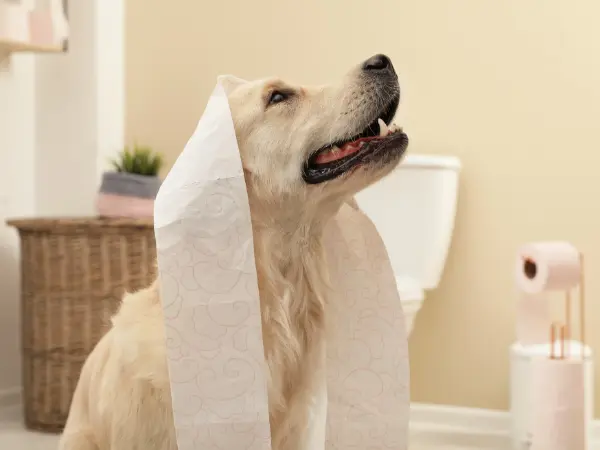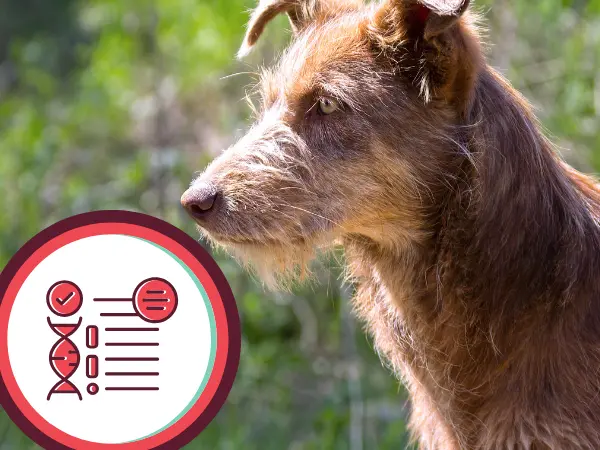Dog shedding is a natural process by which dogs lose old, damaged hair or a winter coat that they no longer need. Now and then, dog parents may experience an increase in dog shedding, whether it’s seasonally linked or because of other reasons.
Though dog shedding is normal, excessive dog shedding can be linked to nutritional deficiencies, skin issues, or other health issues.
The team at Sploot Veterinary Care prepared this comprehensive guide to help pet parents recognize abnormal, excessive dog shedding—and what to do about it.
Overview:
- A certain amount of dog shedding is completely normal, as this helps replace old, damaged hairs with new strands.
- Dogs can shed excessively due to triggers like seasonal changes, allergies, stress, and other factors.
- We always recommend consulting a veterinarian if you notice excessive or sudden shedding in your dog.

Dog Shedding Overview
Dog shedding refers to the natural process in which a dog's old or damaged fur is replaced by new growth. Some dogs shed a lot while others may shed less or minimally.
Do All Dogs Shed?
Yes, all dogs shed to some extent. However, the amount and frequency of normal dog shedding can vary greatly depending on the breed. Factors such as age, health, hormonal changes, and nutrition also play a role in the shedding process.
What Dogs Shed the Most?
Certain dog breeds are known for their heavy shedding tendencies. Breeds with double coats or thick, dense fur are more likely to shed excessively. Dog breeds that are considered as heavy shedders include the following:
- Samoyed - double coat, long-length, prone to heavy dog shedding
- Siberian Husky -double coat, medium-length, prone to heavy dog shedding
- Akita - double coat, medium-length, prone to heavy dog shedding
- Bernese Mountain Dog - double coat, medium-length, prone to heavy dog shedding
- Pembroke Welsh Corgi - double coat, short-length, prone to heavy dog shedding
- Chow Chow - double coat, medium-length, prone to moderate to heavy dog shedding
- German Shepherd - double coat, medium-length, prone to moderate to heavy dog shedding
- Shiba Inu - double coat, short-length, prone to prone to moderate to heavy dog shedding
- Labrador Retriever - double coat, short-length, prone to moderate to heavy dog shedding
- Golden Retriever - double coat, medium-length, prone to moderate to heavy dog shedding
All of the above dog breeds are known to shed heavily. However, they may shed even more than usual due to seasonal changes (spring, autumn), nutritional deficiencies, health conditions, skin issues, allergies, and stress.
Note: If you own any of the above dog breeds or other heavy-shedding dog breeds, we highly recommend monitoring your dog’s shedding patterns. This way, if you notice any sudden changes, you will be able to consult a vet.
What Dog Breeds Don't Shed?
All dogs shed to some extent. There is no such thing as a ‘non-shedding dog breed’. There are, however, dog breeds that shed very little and are considered relatively hypoallergenic.
Many low-shedding dog breeds are single-coated or have hair instead of fur. When a dog has hair instead of fur, the strands continue to grow instead of shedding. Here is a list of low-shedding dogs and details about their coat makeup:
- Poodle - single coat, dense curly hair, low-shedding dog breed
- Bichon Frise - double coat, dense curly hair, low-shedding dog breed
- Maltese - single coat, long silky hair, low-shedding dog breed
- Havanese - double coat, long silky hair, low-shedding dog breed
- Shih Tzus - double coat, long silky hair, low-shedding dog breed
- Yorkshire Terriers - single coat, long silky hair, low-shedding dog breed
- Schnauzers - double coat, short-length fur, low-shedding dog breed
- Beagle - double coat, short-length fur, moderate dog shedding
- Doberman - single coat, short-length fur, moderate dog shedding
Note: Though the above dog breeds are low-shedding or only moderate shedders, it’s still important to look at their shedding patterns. We also encourage pet parents to watch out for symptoms like excessive itching or scratching or visible changes to the fur or skin. Consult a veterinarian if you notice any of these signs.

Why is My Dog Shedding So Much?
In the above sections, we established how the breed of a dog can influence why they shed a lot (or comparatively less). Along with these breed predispositions, other factors influence shedding. These include:
1. Seasonal Dog Shedding
Dogs, especially double-coated breeds, often shed more during spring and fall. This is known as seasonal shedding; it is a natural response to temperature fluctuations and daylight hours. When a dog goes through seasonal shedding, they either shed their winter coat or their summer coat in preparation for seasonal temperature changes.
2. Allergies in Dogs - Seasonal, Food, & Fleas
Allergies in dogs can cause them to shed more than usual. Other symptoms of allergies in dogs include excessive scratching or itchiness, gnawing at the paws, and increased susceptibility to ear infections.
For dogs, there are three common sources of allergies: seasonal air-borne particles, food, and fleas. Here are more details about common allergy triggers:
- Seasonal allergies (spring allergy in dogs, autumn allergy in dogs) — this can be due to increased pollen, dust mites, or mold spores
- Food allergies in dogs — many dogs are allergic to certain proteins like chicken, turkey, beef, or seafood
- Flea allergy in dogs — fleas do not only carry disease and cause itchiness, and they can also trigger allergic reactions if a dog is allergic to flea saliva
Note: It can be challenging to distinguish between seasonal allergy-induced shedding and natural seasonal shedding. As always, if you suspect that your pup has allergies, we recommend consulting a veterinarian.
3. Skin Issues
As mentioned above, fleas can cause increased dog fur shedding if they trigger allergies. In addition, the bites of fleas, as well as ticks, cause itch and discomfort, leading a dog to scratch excessively. Over time, excessive scratching can also cause increased dog shedding.
→ Learn more - 11 Flea & Tick Control Products for Dogs [Prevent & Treat]
Other skin conditions can also cause hair loss. For example, sarcoptic mange in dogs, also known as scabies, leads to itching, hair loss, and scabbing. Another common culprit for abnormal, excessive dog shedding is ringworm in dogs, a fungal infection that causes circular patterns of hair loss or broken fur strands.
Note: Both ringworm and sarcoptic mange in dogs can be transmitted to humans — if you notice ringworm or scabies symptoms in your pup, make sure to book an appointment with a vet clinic promptly.

4. Dietary Factors
A diet lacking essential nutrients can lead to unhealthy skin and coat conditions, resulting in increased shedding. Ensuring your dog receives a balanced diet with high-quality ingredients is crucial for their overall health and coat condition.
5. Health Issues
Certain underlying health issues may also cause hair loss in dogs. Systemic problems like hypothyroidism, diabetes, and Cushing’s disease are fairly common in dogs — and they affect the natural hormonal balance in a dog’s body. This leads to increased dog shedding or thinning fur.
If increased dog shedding co-occurs with symptoms like lethargy and weight loss, make sure to consult a veterinarian.
6. Stress & Anxiety
Stressful situations, changes in routine, or anxiety can trigger excessive shedding in dogs. This can include events like moving to a new home, the introduction of a new pet, or loud noises like fireworks.
How to Stop a Dog From Shedding
Shedding in dogs is a natural process; thus, shedding in dogs cannot be stopped completely. However, here is a list of steps that pet parents can take to make sure that shedding is managed and any underlying causes of abnormal shedding are addressed:
1. Regular Grooming
Dogs need baths every 1 - 3 months, depending on their activity level and lifestyle. In addition, regular fur brushing will help reduce a dog’s shedding. This is especially important for dogs that tend to shed heavily throughout the year (such as the examples of heavy-shedding dogs discussed above.)
Regular grooming also helps ensure that pet parents get an opportunity to observe their canine companion’s skin and fur condition closely. This is why grooming is an essential part of a regular dog care routine.
- → Learn more - Routine Dog Care for Health & Well-Being [Vet-Approved Checklist]
- → Learn more - 5 Best Oatmeal Shampoos for Dogs for Moisturizing [Vet Picks]
2. Balanced Diet
Ensure your dog is receiving a balanced diet rich in essential nutrients, including omega-3 fatty acids, which promote healthy skin and coat.
→ Learn more - Fish Oil for Dogs [Omega 3]: 5 Vet Picks, Benefits & Side Effects
In addition, choose AAFCO-certified dog food, which meets established nutritional standards for a balanced diet. Dog-friendly, healthy people foods are also great additions as pet food toppers or treats, comprising no more than 10 percent of a dog’s daily intake.
Consult a veterinarian to determine the best diet for your dog's specific needs, ruling out any suspected food allergies or dietary intolerances.
3. Regular Vet Check-Ups
Schedule regular veterinary check-ups or wellness exams to monitor your dog's overall health and address any underlying issues that may contribute to excessive shedding. A veterinarian can recommend appropriate treatments or medications if necessary.
4. Stress Management
Stress management for dogs promotes overall well-being, helping reduce stress-induced dog shedding among many other benefits.
One of the key ways to promote a calm, nurturing environment for dogs is to stay consistent with a dog care routine. In addition, regular dog walking, bonding activities with dogs, and establishing a safe space at home will help keep a pup free of stress.

Final Thoughts on Dogs Shedding a Lot
While shedding is a natural and necessary process for dogs, excessive shedding can indicate underlying health issues that need to be addressed.
By understanding the reasons behind your dog's shedding and implementing proper grooming, nutrition, and stress management techniques, you can help minimize shedding and maintain a healthy coat for your furry friend.
Get All-in-One Veterinary Care for Dogs at Sploot Vets
Wondering why your dog is shedding so much? Or looking for personalized ways to minimize excessive shedding? We’re here to help.
Sploot Veterinary Care provides all-in-one vet care—with primary care, urgent care, and emergency vet services under one roof. We offer utmost convenience—as well as next-level, Fear Free veterinary care that prioritizes your pet’s comfort and wellbeing.
Experience the Sploot Difference today! Visit one of our vet clinic locations in Denver, Chicago and Colorado Springs; we’re open 365 days a year, with extended vet clinic hours.
Schedule an appointment easily online or through the Sploot Vets app, your trusted mobile pet care companion.
Until next time, we're here for you every pounce of the way!






